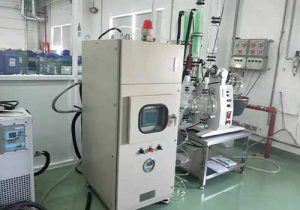laboratory chillers
Laboratory Chillers: A Comprehensive Guide
Laboratory chillers are essential for maintaining precise temperature control in research, medical, and industrial settings. Unlike commercial refrigeration systems, they are designed for accuracy, reliability, and compatibility with sensitive scientific equipment.

- How Laboratory Chillers Work
Laboratory chillers operate on the same basic principles as refrigeration systems but with enhanced precision:
Refrigeration Cycle:
Compressor: Circulates refrigerant.
Condenser: Releases heat to the environment.
Expansion Valve: Lowers refrigerant pressure.
Evaporator: Absorbs heat from the process fluid.
Coolant Circulation:
A pump circulates a heat-transfer fluid (water, glycol, or specialized coolants) through the system.
The fluid absorbs heat from the application and returns to the chiller for cooling.
Temperature Control:
PID controllers adjust cooling output to maintain setpoints within ±0.1°C.
Some models feature touchscreen interfaces for programming cooling profiles.
- Types of Laboratory Chillers
A. Recirculating Chillers
Most common in labs.
Coolant is continuously circulated between the chiller and application.
Available in air-cooled (for smaller labs) and water-cooled (for high-capacity needs).
B. Immersion Chillers
Directly cool samples by submerging cooling coils in liquids.
Used in small-scale experiments.
C. Modular Chillers
Scalable systems for large laboratories.
Multiple units can be linked for higher cooling capacity.
D. Specialty Chillers
Low-Temperature Chillers: Reach -40°C or lower.
Explosion-Proof Chillers: For hazardous environments.
- Key Features of High-Performance Chillers
Precision Control: PID algorithms maintain tight temperature stability.
Corrosion Resistance: Stainless steel or polymer components for chemical compatibility.
Energy Efficiency: Variable-speed compressors reduce power consumption.

Safety Features:
Low-fluid alarms
Overheating protection
Leak detection
- Applications in Scientific Research
A. Analytical Chemistry
HPLC (High-Performance Liquid Chromatography): Prevents column overheating.
NMR (Nuclear Magnetic Resonance): Maintains magnet stability.
B. Pharmaceutical & Biotechnology
Bioreactors: Controls fermentation temperatures.
Lyophilization (Freeze Drying): Provides consistent cooling.
C. Materials Science
Polymer Testing: Prevents thermal degradation.
Laser Systems: Cools optical components.
D. Medical & Clinical Labs
Blood Analyzers: Ensures accurate test results.
Cryopreservation: Stores biological samples at ultra-low temperatures.
- Selecting the Right Laboratory Chiller
Consider these factors:
Cooling Capacity (measured in kW or BTU/hr)
Match to the heat load of your equipment.
Temperature Range
Standard: +5°C to +35°C
Low-Temp: -40°C to +5°C
Coolant Compatibility
Water for mild conditions.
Glycol mixtures for sub-zero applications.
Flow Rate Requirements
Ensure sufficient circulation for uniform cooling.
Footprint & Noise Levels
Compact, quiet models for shared lab spaces.

- Maintenance & Troubleshooting
Routine Care:
Filter Cleaning: Prevents clogging.
Coolant Replacement: Avoids bacterial growth.
Condenser Coil Inspection: Ensures efficient heat dissipation.
Common Issues:
Fluid Leaks: Check seals and connections.
Temperature Fluctuations: Calibrate sensors.
Reduced Cooling Efficiency: Clean heat exchangers.
- Future Trends in Laboratory Chilling
Smart Chillers:
IoT-enabled remote monitoring.
Predictive maintenance via AI.
Eco-Friendly Designs:
Natural refrigerants (CO₂, hydrocarbons).
Energy recovery systems.
Miniaturization:
Portable chillers for fieldwork.
Conclusion
Laboratory chillers are indispensable for precision temperature control in research and industry. Choosing the right system—based on cooling needs, application compatibility, and energy efficiency—ensures reliable performance. As technology advances, smarter and more sustainable chilling solutions will continue to evolve, supporting cutting-edge scientific discoveries.
Related recommendations
industrial heat transfer
397What Is Industrial Heat Transfer?Industrial heat transfer is the process of moving thermal energy from one medium to another in manufacturing, chemical processing, power plants, and other industri...
View detailshot water bath equipment
377Introduction to Hot Water Bath EquipmentHot water bath equipment is a critical component in many scientific and industrial processes where temperature control is essential. These devices provide a...
View detailslow pressure chillers
541Understanding Low Pressure Chillers Low pressure chillers are a subset of industrial refrigeration systems that operate at lower pressures than conventional chillers. They use low pressure refr...
View detailsThe Main Application Industries of Industrial Chillers
1526The Main Application Industries of Industrial Chillers Food industry: Some foods are thermally processed. In order to ensure convenience, they need to be cooled immediately after processing...
View details
 LNEYA Chiller
LNEYA Chiller







HelloPlease log in